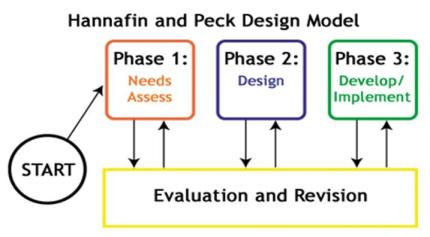Multimedia Development Process
There are several types of Multimedia Development Process Model.For Educational multimedia courseware, INstructional Design Model has been use. Example of ID:
ADDIE model

The Analysis is the most important step in the process. It helps you to determine the basis for all future decisions. A mistake that many beginners make is not conducting a proper analysis at the beginning. It is this analysis that helps you identify your audience, limitations or opportunities, or other important points that will be useful in the design process.
The Design process is the brainstorming step. This is where you use the information obtain in the Analysis phase to create a program or course that meets the needs of your customer or audience. There are many forms of the design process and it can be very tedious at times. Testing your concepts in the design phase will save you time and money.
The Development phase focuses on building the outcome of the design phase. This process consumes much of the time spent in creating a sound educational program or course. It includes various steps such as initial drafts, reviews, re-writes, and testing. For larger corporations, this phase can involve numerous individuals to include subject matter experts (SME), graphic artists, and technical experts. For elearning courses, this phase could require additional assistance for managing server space and technology.
The Implementation phase includes more processes than simply presenting the materials developed. While the concepts and materials have been tested throughout the process, the implementation phase can uncover topics that require further development or re-design work. The processes for this phase vary based on the size of the organization, the complexity of the program or course, and the distribution of the materials. This includes such concepts as test pilots, train-the-trainer sessions, and other delivery methods to present the materials.
The Evaluation phase plays an important role in the beginning and at the end of the process. Evaluation objectives reflect much of the discoveries found in the Analysis process. These discoveries include the objectives and expectations of the learner. When looking at the process, you must avoid the thought that it is structured in a chronological order. Rather, the ADDIE Model is a continuous circle with overlapping boundaries. Of all of the process phases, the evaluation phase is the lest understood.
Hannafin & Peck Design Model

This model emphasizes the important of evaluation and revision. This model is linear in nature and requires completion of a particular phase before moving on to the next
Waterfall Model

This model is said to be the earliest method of structured system development in a traditional approach. The simplest possible process model and therefore, the least likely to be correct. The waterfall model is widely used despite of being too inflexible and linear when it comes to meeting its customer’s needs. It models the software development process as a stately and chronological through the previously mentioned phases. As we can see in this model, Waterfall development has distinctive goals for each phase of development where each phase is completed for the next one is started and there is no turning back. Though it is orderly, simple to understand, and represents a process that is easy to manage and measure, the problem is that not even the simplest systems actually get built that way. But of course, in such methods and techniques, there’s always an advantage on it despite of the negative. And the seeming advantage of the waterfall process is that it allows for departmentalization and managerial control. It is because there is a schedule that is typically set with deadlines for each stage of development and a product can proceed through the development process.






